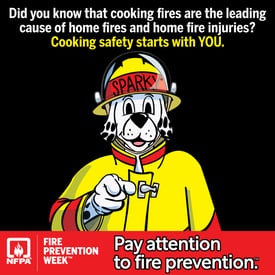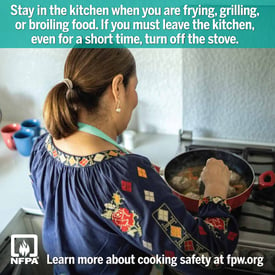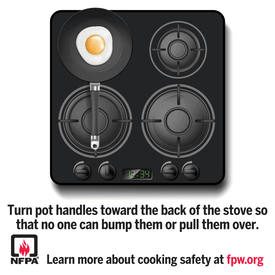
It’s officially Fire Prevention Week – a week promoting fire safety and prevention by the National Fire Protection Association (NFPA). The theme this year? “Cooking safety starts with YOU.”
You may not think about fire safety while prepping a meal, but it’s one of the riskiest times when it comes to fire risks. In fact, cooking fires are the leading cause of home fires and home fire injuries, and unattended cooking is the leading cause of cooking fires and deaths.
Fortunately, there are many ways you can reduce your fire risk in the kitchen. We’ve rounded up some tips from NFPA below to help keep you – and your family – fire safe.
Create a "kid-free zone"
One of the best things you can do to keep your family safe is create a kid and pet free zone around the stove and oven when you are cooking. Kids and pets should be at least three feet away from cooking at all times. If you’re carrying hot food, the rule still applies – keep them three feet away.
When in doubt, keep kids and pets out of the kitchen entirely until it’s time to eat.
"Cook with caution"
The NFPA suggests everyone should “cook with caution” – meaning, only cook when you are fully alert and aware, not when you’re sleepy or under the influence of alcohol or other substances. Additionally, always stay in the kitchen when frying, broiling, boiling or grilling food, and  regularly check on food that is simmering, baking or roasting. Never leave the house while these activities are happening, and set a timer so you don’t forget about your food.
regularly check on food that is simmering, baking or roasting. Never leave the house while these activities are happening, and set a timer so you don’t forget about your food.
If you’re using a slow cooker, you’ll likely be leaving the house while it’s on. Make sure to keep the slow cooker far away from anything that could catch fire, and in a place where it won’t be bumped. Keep the lid on it securely so the liquid won’t boil away, which could result in the slow cooker overheating and starting a fire.
If using a pressure cooker, again safety guidelines must be followed. Place the cooker in an open area with proper ventilation for the steam, never cover the steam release valve, and do not leave the home while using it. If using an air fryer, again give the appliance plenty of space and ventilation, make sure to clean it after every use (once it’s fully cool and unplugged), and don’t leave the house while it’s on.
Pay attention to your environment
 Another factor in fire safety in the kitchen is the environment itself. When cooking, always keep pan handles turned inward, away from the counter, to avoid knocking them and spilling hot food. Make sure anything that can catch fire – such as oven mitts, wooden utensils, towels and curtains – is away from the stovetop so they don’t pose a risk.
Another factor in fire safety in the kitchen is the environment itself. When cooking, always keep pan handles turned inward, away from the counter, to avoid knocking them and spilling hot food. Make sure anything that can catch fire – such as oven mitts, wooden utensils, towels and curtains – is away from the stovetop so they don’t pose a risk.
When placing hot food on the table, like soup, place the food well away from the edge of the table, so it can’t be knocked over and potentially burn someone.
Know what to do if a fire happens
Sometimes, fires will happen – and it’s essential that you know what to do if one breaks out.
If a grease fire breaks out on the stove, smother the flames by sliding a lid over the pan and turning off the burner. Leave the pan covered until the pan and food are completely cooled.
If a fire happens in the oven, leave the door closed and turn off the heat. If you open the door, you’ll add oxygen and encourage the flames.
When in doubt, just get out, as the NFPA says. Leave the house and close the door behind you to help contain the fire. Call 911 from outside of your home and let the professionals check everything out before going back inside.
Fire prevention week is a great time to check in with your family about fire safety and prevention. Make sure everyone knows what to do in case of a fire emergency, and check your smoke detectors if you haven’t yet this month.
Want even more fire and life safety tips? Check out our other blogs at CertaSitePro.com.




